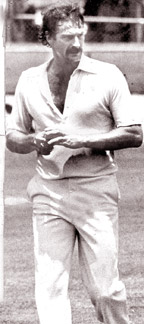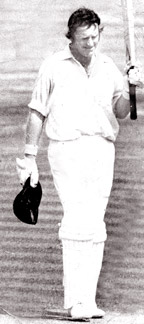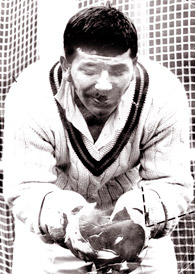Watching the bowler from start to delivery very important - Gooch
By A.C. De Silva
FLASHBACK..... What do you do when the bowler's running in to hurl it
down at you? The best and most sensible thing to do is to watch him from
the start of his run. There is a mannerism of the batsman taking strike
to look down at the crease when he (the bowler) is in the middle of his
run and in the last few yards.
The batsman taking strike should concentrate on his bowling arm and
after that, it's back to the basics and the instinctive reactions.
|

Dennis Lillee Ė had a field day taking 6 for 26 and 5 for
139 in the first and second innings in Englandís 96 in the
first innings and in Englandís second innings score of 417. |

Dennis Amiss made 64 in Englandís second innings score of
417 against Australia. He was deservedly awarded the
man-of-the match award.
|

David Hookes made 56 in Australiaís second innings score of
419 for 9 wkts declared.
|
Some batsmen have a slight backlift at the start, may be a foot off
the ground and the batsman's bat would be going up just as the bowler
lets fly. It's then a split-second thing. The batsman will not have the
time to wait to see where the ball is going to pitch, but the batsman
will have to pick up the line and its trajectory and work out
instinctively whether it's on a full length or dropping short. The
batsman will be on his own and have to back his judgement such as it is.
You can coach someone at the nets, but it is the player in the middle
will have to pick the correct shot for the appropriate ball.
Judge the bounce
If the wicket's bouncy one, the batsman will have to be extra careful
to get behind the line. Australian speedsters Lillee and Thomson got
stacks of wickets in Australia against the West Indies and the
Englishmen by surprising them with their bounce.
A typical dismissal would be when the batsman was surprised by the
extra bounce so that he was out of position and lamely edging the ball
to Marsh or one of those superb slip fielders. Many of these deliveries
would never have hit the stumps, but they kept coming in at the batsman
so he was mesmerised eventually.
Players like Redpath and Boycott were always masters at swaying out
of the way of such deliveries - they could pick up the line of the ball
so quickly that they could easily sway gently away, even though the ball
was fairly straight.
This method would not work out on English wickets, where the bounce
isn't so steep, but works in Australia.
Bat-pad technique
A different technique is needed on a typical English seamer's wicket.
You need your pads as a second line of defence because the ball can
deviate so much - if you're playing forward, and don't play a shot and
the ball nips back and hits your pad. You usually won't be given out lbw.
This is the way to avoid being bowled 'through the gate, I.e. When he
ball passes between your bat and pad. This is a tyipcial dismissal on a
seamer's wicket and you must have that pad clsoe to the bat and get well
forward if the ball's keeping low.
Don't worry about lunging forward because if you'e hit on the paid
the chances are your'e too far forward or the ball would have missed the
stumps, so that you won't be given out lbw. If you're getting dismissed
a lot in the bat/pad position at short leg, perhaps that's because
you're not hitting the ball hard enough - most of the catches in that
position are from little nudges and half-cock shots, so follow, through
with your attacking shot and if the bloke at bat-pad picks you up off a
full-blooded shot, then he deserves your wicket.
Playing swing
|

Rodney Marsh made 110 not out in Australiaís second innings
score of 419 for 9 wkts declared.
|
Late swing needs to be played calmly don't commit yourself too soon.
Try to pick up the line of the ball quickly, but rememebr it doesn't
really start to swing until it's half way towards you. The late out
swinger is a problem - you can have it nicely lined up about leg and
middle, it starts to swing a little and you aim for the on-side, but
then it straightens up and you're out lbw or (even worse) clean bowled.
No real physical worries about swing bowling, but it keeps you on your
toes mentally.
To hook or not?
One thing you have to work out for yourself when facing fast bowling
- are you going to play the hook or the full shots? You have to decide
if you play them well enough. So take some advice and get in the nets to
practise against short-pitched fast bowling. If you can play them
properly. You'll make a lot of runs and don't worry if you get out to
the hook or the pull now and then.
In my case, I don't play the hook shot unless I'm well settled, the
bowlers are tired and I'm seeing the ball well.
There's an old saying that you shouldn't hook until after tea and
that's not a bad adage in my opinion because so many things can go wrong
- the ball can be on your too soon, or you play the shot too prematurely
or you may have a habit of hooking in the air I'm happier with the pull
shot because you can play that off a long hop from a medium pacer. No
real need to worry about misjudging the pace of the wicket there.
Viv Richards is the best hooker and puller of the fast stuff I've
seen anything fractionally short he murders. Clive Lloyd gets over the
ball well and rarely seems ruffled by the quicks - mind you, he's been
playing them for years. Graeme Wood, the Australian opening batsman,
plays the fast men well - very much an on-side player and not much of a
driver, but he nudges and deflects well and seems to enjoy the
challenge.Playing fast bowling can be fun if you get it right - but it's
never as much fun as playing spin bowling. |


